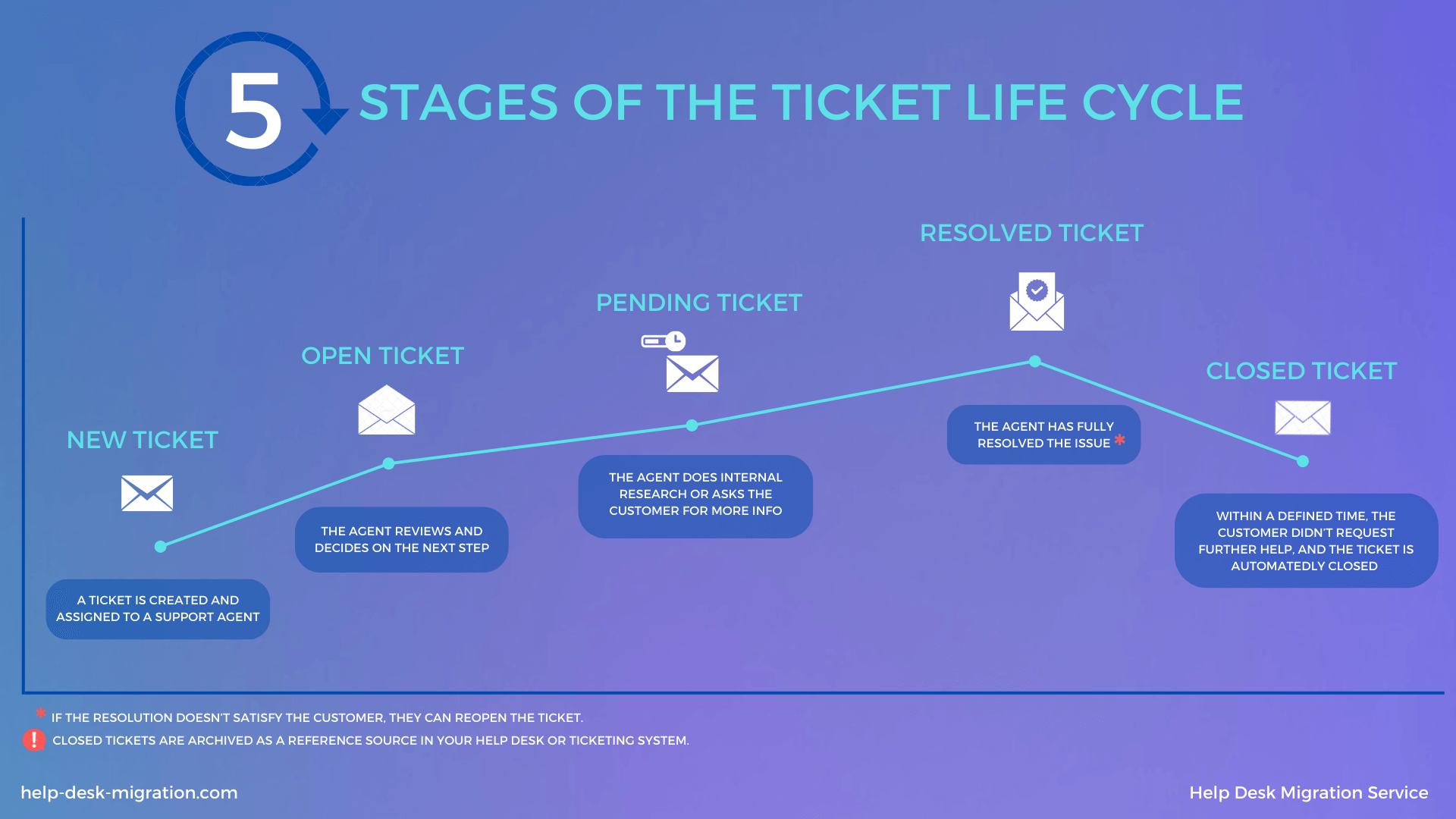Your help desk solution lies at the core of your customer support operations. It’s your team’s hub for ensuring your business engages with customers in ways that positively impact your bottom line. Unfortunately, help desk interactions aren’t always as smooth as you’d like them to be.
With help desk agents juggling customer complaints and requests, internal team dynamics, and task prioritization, workflows can easily get out of whack. Fortunately, there’s no shortage of software solutions to help streamline your operations. Particularly notable are help desk ticket management systems, which make a huge impact on organizations of all sizes.
Research reveals that companies earn three dollars for every dollar they invest on customer service platforms, like help desks. Considering that US businesses lose more than $62 billion yearly due to poor customer service, companies have much to gain by putting a help desk system in place.
To fully capture help desk benefits, it pays to review the basics.
What Is Ticket Management?
Help desk tickets represent interactions between service help desk agents and customers, and ticket management is the process of tracking, organizing, and resolving support tickets. Every time a customer reports an issue or sends a request, the support team opens a ticket. Customer queries may come from multiple channels, including live chats, phone calls, emails, and customer portals.
Customer service departments rely on help desk ticketing software to streamline their workflow and ensure that nothing falls through the cracks.

Who Needs a Help Desk Ticketing System?
No matter what your industry, customer problems and questions are inevitable. Hence, all organizations need an efficient way to handle issues and requests.
A growing customer base can bring with it a mountain of support issues, phone calls, and request emails. Not even your most enthusiastic employees can handle such an enormous load. With a help desk ticketing system, there’s a better chance of ensuring every issue is captured, recorded, monitored, and resolved. The right software enables you to scale operations without staff becoming overwhelmed by ticket volume.
How Does Ticket Management Relate to Help Desk Strategy?
Inefficient ticket management can result in service level agreement (SLA) breaches and unmet key performance indicators (KPIs), which ultimately impact customers. The support team may grapple with unnecessary escalations that lead to excess costs. That’s where software-based ticket management comes into play.
Help desk ticketing software generates tickets and categorizes them based on factors like their status and priority level. It’s more efficient than the traditional first-in, first-out method of addressing customer concerns.
Once the system generates a ticket, your agents can track its progress until it’s resolved. Depending on the nature and complexity of a concern, a ticket can be prioritized, escalated, or assigned to a different department. Besides, a tiered support structure of tickets enables agents to quickly resolve simple issues and provide ample attention to more complex ones.
To make ticket handling more efficient, customer support teams often integrate a knowledge base into their help desk. It both equips agents with information on known issues and provides end-users with self-service options. As a result, you can address customer requests in the shortest period of time, or in accordance with SLA metrics.
What Features Should You Look for in Help Desk Ticketing Systems?
Not all ticket management systems are created equal. With so many options on the market, how do you choose a good system? Here are the key features to watch for.
Ticket automation
Ticket automation helps support teams perform tasks like sending automatic responses to users, setting up triggers to move tickets to a higher tier based on certain keywords, and reminding representatives to respond to issues and requests. A must-have for every help desk system, this powerful feature allows customer service teams to create rules for handling tickets. Those rules can then be used to automate various tasks.
SLA status information
With SLA information integrated into a corporate ticket management system, representatives can view and gauge the urgency of a ticket with just one glance, prioritize tasks, and prevent SLA violations.
Macros (aka canned responses) for agents
Choose a system that offers the flexibility to create and combine canned responses or message templates, making it much easier to respond to tickets that vary in complexity. Your support representatives should be able to instantly access these templates anytime to deliver quick answers to the common problems your customers have.
Customizable ticket status options
Your support team may have its own way of doing things. Hence, no standardized ticket statuses can cover your support team’s needs. Go for a system that lets agents add your preferred options. It should also allow you to trigger certain actions when a status changes.
If you got several lines of customer support, you can define in the ticket status what support line should handle the tickets with this status. For example, you can create such ticket statuses:
- Waiting for tech support response
- Waiting for Sales rep response
- Waiting for Pre-sale response
and route tickets into the corresponding queries. A good way to optimize your service team performance.
Customizable ticket submission form
You’ll also want customizable customer-facing ticket forms. You need to be able to add fields that fully capture the information your team needs from customers. How can it work in a real-life performance? You can add different forms on different pages on your website.
For example, a customer who has an issue fills in a form on the product page, while a potential partner submits a form on a partner page. That way you got two different tickets assigned to the corresponding agents. This will help avoid wasting time trying to ask for additional information.
Personalized information pages about customers
Customer representatives can resolve issues better when they have ample information about the customer. Your ticket system should include pages with a customer’s profile, the number of times they’ve sent a complaint or request, their satisfaction ratings for past tickets, and much more.
Ticket tags
Ticket tags allow your help desk agents to spot common issues or trending requests. The information you glean will help you plan effective responses. For instance, you can set the system to automatically recommend knowledge base articles that address the customers’ concerns based on their assigned tags.
Ticket deflection
Tickets that can be easily addressed with a knowledge base article should be routed to the right link using built-in deflection capabilities. Try to ensure that your customers won’t have to scour your site for the right article.
Individualized ticket queues
Instead of routing all tasks through a single queue, your system should be able to assign a separate list of requests to each employee or agent group. This way, the representatives can focus on their own task lineup, while still having a view of their colleagues’ queue so they can offer a helping hand wherever possible.
Private and public actions
Your employees may have conversations regarding a ticket that customers don’t need to see. For example, you and your colleagues may need to discuss the best resolution to a complex technical problem. Your system should allow you to have some messages restricted to viewing by employees and other messages that are viewable by customers. A good example is side conversations in Zendesk. Those are spaces in a ticket where agents can have a side conversation with a certain group.
5 Best Practices to Optimize Support-Ticketing Workflow
Ticket management goes beyond just prioritizing tasks. To ensure a satisfactory experience for both your employees and your customers, take stock of the following industry best practices.
Clearly define your SLA
Your SLA should clearly define the level of service your customers can expect from you. It should include a set of metrics that will help you measure and assess whether you’re meeting those service standards.
With an SLA in place, you’re better equipped to prioritize support tickets, hold your representatives accountable, and thereby, create a better experience for your customers.
Prepare an arsenal of self-service tools
Self-service tools provide customers with instant access to an answer or issue resolution. These tools free up service representatives to work on problems that require their expertise and direct monitoring.
For example, research shows that 37% of consumers prefer chatbots to get quick answers in an emergency. Chatbots simulate conversations and can deflect tickets that don’t require the attention of agents. Needless to say, it’s a must-have for your help desk system.
Another essential self-service tool is a knowledge base. Instead of reaching out to representatives, your customers can search for answers they need in your online library. Zendesk research reveals that 69% of customers would rather resolve issues on their own, and 63% begin by searching for answers on the company’s website. A well-stacked knowledge base helps prevent overloading help desk agents with tickets.
Organize your ticketing system workflow into a tiered support structure
A tiered support structure lets you take a layered approach to handling tickets. For example, representatives on tier one may handle concerns that can be resolved within ten minutes or less, whereas those on tier two fix more complex issues that require more time. A team of hybrid agents can make up tier three, which takes care of VIP customer needs. Specialists take charge of tier four issues, which include those that require extensive technical expertise.
Allocating tickets by level of complexity allows representatives to resolve them more efficiently.
Prepare message templates to speed up response time
Customers often have high expectations when it comes to response time. They expect to hear back from representatives in a live chat in less than one minute, and they offer a leeway of three to four hours for email response times. Predefined ticket actions or messages can reduce the time it takes to respond to customers’ concerns.
For incoming chat messages, you can program a bot to ask questions that help customers better explain their issues. For customers submitting their concerns via text, send automated responses informing them that their message was received. Agents can quickly update or customize predefined response templates to address common problems and requests sent in via email as well.
Update ticket tags
Help desk systems automatically assign tags to tickets using short descriptors that categorize issues and let representatives prioritize them accordingly. Over time, these generic descriptors fail to cover all situations as agents deal with diverse problems and new information. You can train your representatives to add tags that provide context.
For example, adding the label system_crash can serve as a cue to assign a ticket to a higher tier. Agents can also use tags to categorize customers who are likely to quit a subscription, based on the tone of their voice or the escalation of their tickets.
5 Best Ticketing Systems for SMBs
So, which help desk software solutions should be at the top of your list? Here are the top five service desk ticketing systems to consider:
Zendesk
A go-to help desk solution, Zendesk features a suite of tools to streamline your work processes. It supports ticket creation via multiple channels, including live chat, email, phone, SMS, and social media. Agents find Zendesk easy to navigate, thanks to its responsive design and intuitive interface. They can also prioritize their tasks with a personalized view of their ticket queue.
Freshdesk
A leading help desk ticketing system for small businesses, Freshdesk offers advanced features at a cost-effective price. Your support team won’t have to spend too much time learning to use this intuitive software. Freshdesk comes complete with essential features like automation, a knowledge base, customization, reporting, and analytics. An ideal option for SMBs, this scalable solution is designed to meet your needs as your organization grows. Be sure to check Freddy AI which is good at optimizing your workflow.
ServiceNow
Supported by a strong IT service management (ITSM) framework, ServiceNow’s ticketing system boasts powerful automation, an integrated platform, and fast deployment. It promotes workflow efficiency by getting rid of repetitive tasks and manual processes. A single platform prevents agents from working in silos and reduces resolution time and costs.
ServiceNow requires minimal configuration, letting you deploy a help desk system quickly. Your internal IT ticketing system will be up and running in no time.
Jira Service Management
Designed for B2C companies that rely heavily on their IT infrastructure, Jira Service Management has all the features your support team needs to work collaboratively. It does a superior job of spreading the workload and assigning tickets to specific agents equipped to address particular issues. Prebuilt templates allow agents to customize their responses with a few clicks greatly to reduce response times.
Freshservice (ITSM)
Built for IT support, Freshservice boasts advanced tools like asset management, gamification, problems and changes management, and a unified service portal. Agents can use APIs to view, create, delete, and update domains to access restricted resources. Freshservice supports Amazon Web Services (AWS) integration in several regions, including Beijing, Ohio, and Mumbai. Support staff who are constantly on the road can access the help desk system on their Android and iOS devices.
Conclusion: Why You Need a Ticket Management
Keeping your customers happy leads to increased profitability, growth, and sustainability for your company. Hence, you can’t just settle for a mediocre ticket management system. The right help desk software can speed up your team’s response time, ensure all tickets are addressed, reduce unnecessary escalations, and let customers resolve issues on their own.
Do you think your help desk system could use a boost? You don’t have to remain stuck in your current method of resolving customer issues; you can easily transition to new processes or migrate to a different system. So, how exactly can you make that happen? Find out more by exploring how Help Desk Migration works.



